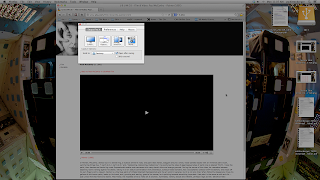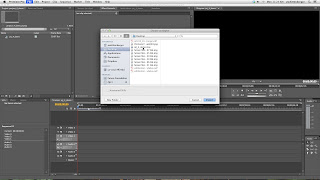Tuesday, February 26, 2013
Apocalypse!!!!
Here is the completed work and it's great! It is visually engrossing, relevant to our contemporary society, and remains both humorous and emotionally gripping while exploring a complex concept. I appreciate all your hard work into the project and think you all should consider it a great success!
Monday, February 25, 2013
Project #4 Video Reenactment
VIDEO ART
1) Visit the website ubuweb and explore the many experimental films and videos available on this site: http://www.ubu.com/film/
Choose a video/film of your liking. Shoot and edit your own version of the chosen video/film preserving the soundtrack from the original source to be added to your video creation. This is an interpretive experiment. Be creative in how you approach this project! You can attempt to recreate or copy the point of view, camera angles, timing, subject matter and such in your original or creatively re-interpret. Your video creation should somehow reflect your chosen work. There are many hundreds of choices on this site - take some time to explore these many varied historical and contemporary works! (You cannot pick Fatboy Slim)
The minimum length of your video should be 45 seconds with a minimum of three cuts.
In our critique we will be viewing your original source video and your reenactment, please be sure BOTH works are embedded blog post as well as your Artist Statement!
Equipment and techniques: You may use anything from a cell phone video camera, laptop webcam to a high end HD camcorder. This is up to you! I recommend you use Adobe Premiere of Final Cut Pro to edit your work after capturing the audio with Snapz Pro X (This program is only available in the lab)
Your video is due, posted to your blog (embed through Youtube or Vimeo) by the start of class time Monday, March 11th.
2) Read "Chapter 2 Video Art" for next week, Monday, March 4th and post two questions on your blog prior to class time. Research artists mentioned in the reading - find videos of their work where possible online as this will greatly enhance your understanding and appreciation of their works! Bring your camera and other supplies as you will have time to work on your projects in the lab.
Nam June Paik
Matthew Barney
Snapz Pro X and Adobe Premiere

Once you have chosen you video, open up the video player in your web browser.
Open Snapz Pro X (usually CMD-SHIFT-5) and select the Movie button.
Move the selection box over you video. (It doesn't have to be perfect as we will be deleting the video track later.)
Make sure the "Capture Mac Audio" button is selected.
Open Premiere and Click "New Project
The New Project interface will open. Name your file and choose the location in which you want to save your file. (Mine will look a bit different because I am using older software, but the process is the same.)
Next, you are given the "New Sequence" options. You want to choose "DV-NTSC" (Digital-Video National Television System Committee) as either Standard48kHz (4:3) or Widescreen48kHz (16:9), whichever one you prefer. The 48kHz is the audio sampling rate.
Go to File > Import, and select your file.
This will import your file to the project window. Drag you file to the timeline and you will separate video and audio tracks. This is how you import your own video to the project window as well.
To delete the original video track, RIGHT click on the video track in the timeline and select "UNLINK."
Now all you have to do is hit delete and the video is gone. Drag your new video to the timeline and use the same process to remove the audio.
After you video is put together, go to File > Export > Media.
This will bring up your CODEC interface. Make sure your settings match this image completely, then hit OK.
Use H.264 (MPEG4), Quicktime, or MPEG2 as your CODED/Compressor so it doesn't take 9 years to load to YouTube or Vimeo.
This will bring up Adobe Media Encoder. This program allows you to make any final changes to your video settings before rendering you file. If you followed the directions you won't have to make any changes except where you want the file to render to (as indicated in the image.) Click "Save Queue" and CONGRATULATIONS, you are a Video Artist!!!
Tuesday, February 12, 2013
UBU Web
UBU Web
In preparation for our next project, please explore the website UBU web. This page contains a large variety of video art pieces from the beginning of video art to today. Please explore the links and find some favorites. You will be using these for your next project. You'll probably find some inspiration for your animations as well!
Reading #2
Here is the second class reading. We will be discussing it on February 25 so please have your questions posted to your blog. Consider the ideas Bishop brings up in regard to the role digital media plays in contemporary art and how they relate to your work.
Monday, February 11, 2013
Project #3: Class Animation and Sound
Tales from the Heart (An animated exquisite corpse, perfect for Valentines Day.) from Droolart on Vimeo.
Instructions:
At this point, you each have an individual 10-20 second animation of your photoshop image. Now, you will work together to link all your animations into one big looping animation sequence! First step is to look at the student blog list after we look at all the animations in class today. Second, meet with the person in front of and after you to create an animated transition that will blend well between your separate animated sequences! Please remember, the expectation is 6 hours minimum per week on outside assignments, you should be spending 3 hours with the person before you and 3 hours with the person after you! Make these interesting and feel free to continue honing your individual animations if you feel it might use some further refining (particularly after seeing the work of your classmates - if you feel as though your work doesn't stand up - make it better!).
1) Consult the Student Blog List.
2) Meet up with the persons in front of you and after you on your list.
3) Brainstorm/collaborate on how best to animate the transition between your works to create a smooth and aesthetically pleasing flow between your animation and your partners.
4) We will be making this piece to exist as a stand alone "single channel" video installation thus you do not need a title or credit sequence - the first and last person's on the list need to mix their start and finish respectively with each other so as to give the impression of a never ending, smoothly transitioning looping video that will go on forever!
5) Sound!
http://www.soundcloud.com/
http://www.freesound.org/browse/
Animation Soundtracks:
Working with Audacity, Soundtrack Pro, Adobe SoundBooth or another audio editing/mixing program of your choice create a unique soundtrack to compliment your individual animation segment.
The audio piece you will create for this will start with four tracks:
* I have selected a "drone" sound that you will all use in your animations. This audio piece will be stored on the first computer's desktop for your downloading convenience. Please do not alter this object as it will be a unifying factor in our final animation. You need to include this in your animation file as we will not be adding it on later
* One sound recorded using a microphone.
* The other two sounds are to be found/downloaded or otherwise appropriated from the internet.
Creatively mix your segment to effectively work with your animated piece - use filtering, repetition, Left/Right stereo mixing to assemble the best possible audio mix that works flawlessly to complete your animated sequence! Remember to create audio for your first transition and your original animation.
Two links to find inspiration from:
Cory Arcangel
Marina Zurkow
* Put your animations and audio together in Final Cut Pro. Remember to export your files using the Animation codec, 30fps, in a .mov file.
6) Animations are due Wednesday, February 20th!!! Save your file and number these "01 LASTNAME". Please upload your file to the folder located on the first computer titled "art_245_ani_whittenberger". This is essential so that we may edit these together! (Since this is a group collaboration, please be patient and flexible so we can successfully complete this project)
Art Events
So here is the list of art events you can choose to attend and write about (please refer to the "Welcome" post for guidelines). These essays are due April 29. Remember the exhibition CADRE at Haldan Art Gallery at Lake Tahoe is a required exhibition. An optional time to visit the exhibition is on Friday, February 22. We will be road-tripping down to the gallery with students from the other section of Art 245. We will rendezvous at Bibo's 3 (just south of campus) at 10 am and head south as a caravan. This is not a required field trip, but all students must visit and write about the exhibition, which closes on March 22.
UNR Spring 13 Events
UNR Spring 13 Events
Monday, February 4, 2013
Project #2 Animation!!
Animation Samples: (find many more on youtube, vimeo, etc.)
http://www.tinkin.com/
http://www.youtube.com/watch?v=CLlJfGybBcc
http://www.youtube.com/watch?v=w7MdpwNvhkU
http://www.youtube.com/watch?v=pIPgWlE2Ybs&feature=related
Create a 10-20 second long animation from your diptych image.
DUE Monday, February 11!!! Since CS3 was introduced, Photoshop now includes some rather simple yet effective animation tools similar to those available in more sophisticated animation programs such as Flash.
•FINISHED ANIMATIONS ARE TO BE EXPORTED FROM PHOTOSHOP AND UPLOADED TO YOUTUBE OR VIMEO FOR EMBEDDING INTO YOUR BLOGS! DO THIS BEFORE CLASS NEXT Monday!•
IMPORTANT SIZE INFORMATION!!!
Everybody, work at the following resolution: 1920 Height x1080 Width at 72 ppi!!!
This is the standard HD 16:9 format although it is rotated for vertical formatting! This is imperative for the next portion of our project. We will create transition animations connecting your work. Everything needs to be in the same format, frame rate, and file format so everything is put together smoothly.
Here are some video tutorials that should help get you started.
Pay particular attention to the brief tutorial using frames for animation and the timeline.
http://www.youtube.com/watch?v=7WdYqPx_SFU
Here's another good one, as well. Pure timeline animation.
http://www.youtube.com/watch?v=Uw0sZwK7az4
These tutorials and others available online have some great information for you! They go through the process pretty fast, don't stress, watch over and over again and try the steps as described on your work.
Most important is to figure out the basics of animation using photoshop for the project. You will want to know how to place your layers in the frames, tweening, durations, movement, etc. Essentially the animation tool allows you to use your layers in an image to animate between them - it is really that simple - the complexity is in figuring out the various tools and using them effectively. Watch these tutorials as many times as it takes to figure out how to animate something. Have fun and get started immediately! If you put this off until the last minute you will not succeed in mastering these tools and creating an interesting animation!
¡¡¡¡¡¡¡¡¡¡¡¡¡EXTREMELY IMPORTANT!!!!!!!!!!
Please make sure to save your files in the format outlined below.
Make sure your files are rendered as a QuickTime Movie (.mov) using the "Animation" codec at 30 fps.
Subscribe to:
Comments (Atom)



















